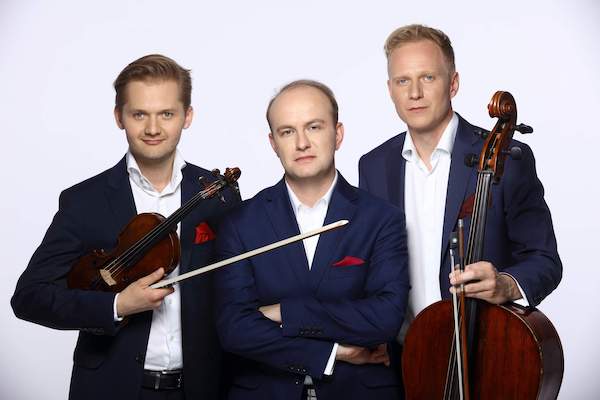Penderecki Piano Trio shows sharp ensemble in reshuffled program

Named after Poland’s leading contemporary composer Krzysztof Penderecki, the Penderecki Trio is one of the country’s foremost chamber ensembles. The chamber group made a stop Thursday night in Libby Gardner Concert Hall, as part of the Chamber Music Society of Salt Lake City’s offerings this season.
The trio’s members (violinist Jaroslaw Nadrzycki, cellist Karol Marianowski and pianist Konrad Skolarski) are wonderful musicians possessing keen musicality and fine interpretative skills.
Unfortunately, the program they chose to play Thursday didn’t put their talents fully on display. Whether that was by design or necessity was difficult to determine. It was also a very short concert, lasting only about one hour and 15 minutes, including intermission and encore.
Two of the works they played deviated from the originally announced program. Instead of Rachmaninoff’s Trio in G minor to open the concert, the group began with Haydn’s Trio in G major, “Gypsy.”
Hearing anything by Haydn is always a delight, and this trio is without question one of his best known and most frequently played chamber pieces. The Penderecki Trio did it full justice, with well-balanced phrasing and nuanced expressions.
The first movement Andante is unusual in that it’s in theme-and-variation form. The theme itself is simple and unassuming, allowing Haydn to develop and explore it in some depth in the variations. The trio played it with finely lyricism and brought cohesiveness to the movement as a whole.
The middle movement, also slow, is one of the composer’s most expressive and tender creations. The music is operatic in character and the musicians gave it apt vocal quality, underscoring the lyricism with subtle shifts in dynamics and phrasing.
The last movement, from which the work gets its nickname, is based on what at the time was considered “gypsy” music. The movement is fast and furious and the musicians played it with flashy exuberance that captured the vitality of the music.
The first half was also to have included a new work by their namesake. However, that was replaced by a piano trio by a much younger contemporary of Penderecki, Pawel Lukaszewski. Written in 2008 the three-movement work is highly romantic in character. The harmonic language is traditional with occasional dissonant chords, but it never strays far from the late 19th century. The music is appealing but lacks substance.
To their credit, the ensemble gave a vibrant reading that emphasized the work’s melodicism. The first movement opens with a steady chordal foundation in the piano over which the two strings at first play sustained tones before moving on to short motivic fragments. The music is overwhelmingly somber, with a few moments of contrast. The three underscored the effect the composer was after with their expressive playing and clarity of articulation.
The middle movement is effusively lush, almost cloying, but the trio managed to bring nuance and definition to their reading.
The Vivace last movement is a perpetual motion. The music is playful with syncopated rhythms and relentless drive. The three captured its spirit with precise and crisp playing.
Debussy’s Piano Trio in G major, the only work remaining from the original program, closed out the evening. Written in 1880 when the composer was only 18 years old, the trio is a solid product of the late 19th century, with lush, almost intoxicating, harmonies and captivating melodies. There is no indication whatsoever in the trio as to how Debussy would evolve as a composer. But it’s a solid, well-crafted work by the teenaged composer.
The trio underscored the youthfulness of the music with their lyrical playing. The opening movement is bright and airy and the three brought out its carefree character well. The middle movement scherzo is likewise lighthearted and charming and the players emphasized the close interplay among the instruments.
The slow movement, reminiscent of a Fauré song, opens with the piano softly accompanying first the cello, then the violin, both of which soar above the piano. Marianowski and Nadrzycki played their respective lines with grace and tender expression.
The music of the finale is filled with sentiment and the three expressed the rich romanticism with exuberance and flair.
As an encore, the trio gave a beautifully expressed reading of Rachmaninoff’s Vocalise.
The Chamber Music Society of Salt Lake City’s next concert features the Imani Winds in a program TBA 7:30 p.m. February 6, 2020, in Libby Gardner Concert Hall. cmsofslc.org.
